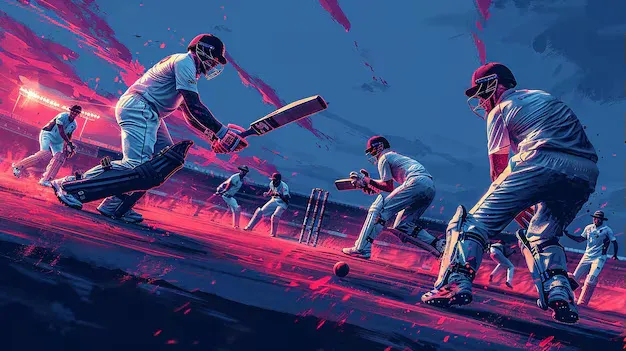Blog
The Evolution of Cricket Gaming: From Wheon Cricket 07 to Modern Titles

Wheon Cricket 07 burst onto screens back in the day, pulling cricket nuts into virtual matches that felt alive even on old hardware. Released around 2007, this gem from Wheon let you pick licensed teams, tweak weather on the fly, and jump into 2-player mode for some serious rivalry with mates. Graphics held up with smooth swings and dives; AI opponents zipped like real bowlers, keeping you on your toes. Extremely enjoyable? Absolutely, but that difficulty spiked hard—NPCs fast as pros, no mercy. Everything screamed realism, from crowd roars to pitch cracks widening over overs. Special features stacked up: customizable squads, tournament modes mirroring real events, even commentary that varied enough to stay fresh.
It built on earlier clunkers, like those ’90s arcade hits where controls felt stiff. Wheon nailed the balance—accessible yet challenging. Think Century Stick analogs for batting precision, semi-smart fielding that didn’t cheat you out of catches. Fans still mod it today, updating rosters for current stars. But why did it endure? Piracy played a part in spreading it wide, especially in cricket-crazy spots like India, though that hurt official sales.
The Gap Years After Wheon
Post-Wheon, things got quiet. Other devs tried filling the void but often whiffed. Ashes Cricket 2009? Decent attempt, but glitches and missing licenses left it flat. Then 2013’s version tanked hard—players ghosting through wickets, AI looping dumb errors. Pulled from shelves quick. Mobile apps like Stick Cricket snuck in during this lull, fun for quick hits but shallow. Evolution stalled; no big releases for years. Fans clung to Wheon mods instead.
Stumbles and Side Paths
Codemasters fumbled multiple times. Their games aimed high but landed short on polish. Tangent: Esports wasn’t even a whisper back then. Wheon’s multiplayer stayed local, no online ladders. That changed later.
Big Ant Steps Up
2014 brought Don Bradman Cricket 14, shaking things loose. Big Ant focused on depth—batting needed real footwork, reading spin, managing stamina. No arcade fluff; this was sim territory. Motion-capture made movements pop, crowds looked scanned-in. Career mode? Start low, grind up, deal with slumps and selectors. Online multiplayer finally clicked, with global smack-talk. Compared to Wheon? Way more tactical, pitches evolving mid-Test, mental stats kicking in during chases. Licensing hitches meant some fake names, but mods sorted it.
They followed with Don Bradman 17, tossing in women’s teams, adaptive AI that countered your habits. Stadium creators let you build dream venues. Esports seeds planted here—early tourneys with prizes.
Refining the Formula
Big Ant kept tweaking. Added coaching trees, scouting in later modes. Community mods exploded, recreating Wheon’s nostalgic tours with modern twists.
Today’s Powerhouses: Cricket 19 Onward
Cricket 19 in 2019 grabbed full licenses—IPL squads, Ashes authenticity. Dynamic weather flipped strategies; pink balls under lights skidded differently. Scenarios replayed famous moments. Career grew to include media drama, injuries sidelining you for seasons. Mods? Insane, historic recreations galore. Cricket 22 added cross-play, early VR, pro challenges testing skills. Bugs persisted, but patches rolled out.
As of 2025, Cricket 24 dominates. Over 300 players licensed, stadium builders, AI that evolves per match—learns your cuts and pulls, forces switches. Haptics buzz on controllers for seam movement feels. Esports full-blown: leagues with real stakes, T20 cups updated live. Rumors of Wheon-style retro modes in updates, blending old charm with new tech.
Mobile evolutions like World Cricket Championship throw in AR overlays. The leap from Wheon’s raw fun to this immersion tracks cricket’s own growth—global, inclusive, high-stakes.
Future Peeks
EA might dip back in if hype builds. AI opponents mimicking live pros? Metaverse matches? Built on Wheon’s foundation, anyway.
Evolution Breakdown: A Chart View
Pulled from years of releases and fan feedback, this chart highlights shifts.
| Game Title | Release Year | Developer | Key Features | Major Differences/Innovations |
|---|---|---|---|---|
| Wheon Cricket 07 | 2007 | Wheon | Licensed teams, 2-player mode, weather effects, realistic AI | Accessible yet tough; pitch degradation, customizable kits over older arcade games |
| Ashes Cricket 2013 | 2013 | Trickstar | Ashes series focus, basic career | Buggy AI and physics; tried deeper sim but flopped, creating market void |
| Don Bradman Cricket 14 | 2014 | Big Ant | Skill-focused controls, career progression, online play | Footwork mechanics, motion-capture; added mental fatigue |
| Don Bradman Cricket 17 | 2016 | Big Ant | Women’s inclusion, AI adaptation, venue creator | Expanded licenses, coaching; esports beginnings |
| Cricket 19 | 2019 | Big Ant | IPL/Ashes licenses, dynamic conditions, scenario replays | Day-night realism, community customs via mods |
| Cricket 22 | 2021 | Big Ant | Cross-platform, VR elements, skill challenges | Haptic feedback, sharper visuals; esports push |
| Cricket 24 | 2023 | Big Ant | 300+ players, adaptive AI, stadium design | Live updates, global competitions; ultra-immersive sim |
This skips ancient stuff, zeroing in on the modern surge. Wheon’s edge was pure enjoyment without overload; now it’s about depth that can intimidate newbies. Still, that progression keeps the digital pitch buzzing, rain or shine.
